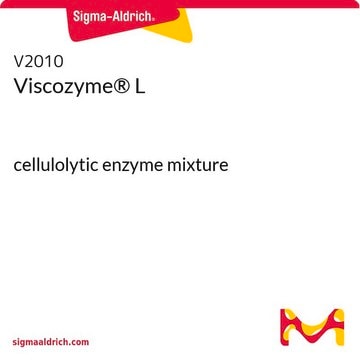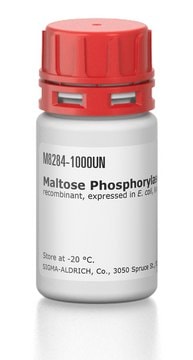This product is provided as a slurry containing 10 mg of enzyme in saturated ammonium sulfate precipitate. It is supplied at 100 units, with a concentration of 0.13 units per 1 mg of protein at 10 mg per ml.
E6412
Cellobiohydrolase I from Hypocrea jecorina
0.13 U/mg, recombinant, expressed in corn
Synonyme(s) :
Cel7A, Cellobiosidase, Cellulase
Sélectionner une taille de conditionnement
170,00 $
Sélectionner une taille de conditionnement
About This Item
170,00 $
Produits recommandés
Produit recombinant
expressed in corn
Forme
liquid
Activité spécifique
0.13 U/mg
Caractéristiques du produit alternatif plus écologique
Design for Energy Efficiency
Learn more about the Principles of Green Chemistry.
sustainability
Greener Alternative Product
Autre catégorie plus écologique
Conditions d'expédition
dry ice
Température de stockage
−20°C
Catégories apparentées
Description générale
Application
Actions biochimiques/physiologiques
Définition de l'unité
Forme physique
Mention d'avertissement
Danger
Mentions de danger
Conseils de prudence
Classification des risques
Resp. Sens. 1
Code de la classe de stockage
10 - Combustible liquids
Classe de danger pour l'eau (WGK)
WGK 3
Point d'éclair (°F)
Not applicable
Point d'éclair (°C)
Not applicable
Faites votre choix parmi les versions les plus récentes :
Certificats d'analyse (COA)
Vous ne trouvez pas la bonne version ?
Si vous avez besoin d'une version particulière, vous pouvez rechercher un certificat spécifique par le numéro de lot.
Déjà en possession de ce produit ?
Retrouvez la documentation relative aux produits que vous avez récemment achetés dans la Bibliothèque de documents.
Les clients ont également consulté
Articles
Uncover more about glycosaminoglycans and proteoglycans including the structure of glycosaminoglycans (GAGs), the different types of GAGs, and their functions.
-
Good morning. This material is liquid. Could you tell me the volume that comes in the bottle?
1 answer-
Helpful?
-
Active Filters
Notre équipe de scientifiques dispose d'une expérience dans tous les secteurs de la recherche, notamment en sciences de la vie, science des matériaux, synthèse chimique, chromatographie, analyse et dans de nombreux autres domaines..
Contacter notre Service technique











